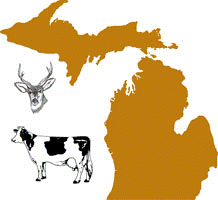Wildlife Disease and Zoonotics
Date of this Version
2002
Abstract
Objective—To identify major environmental and farm management factors associated with the occurrence of tuberculosis (TB) on cattle farms in northeastern Michigan.
Design—Case-control study.
Sample Population—17 cattle farms with infected cattle and 51 control farms.
Procedure—Each case farm (laboratory confirmed diagnosis of Mycobacterium bovis infection) was matched with 2 to 4 control farms (negative whole-herd test results within previous 12 months) on the basis of type of farm (dairy or beef) and location. Cattle farm data were collected from in-person interviews and mailed questionnaires. Wildlife TB data were gathered through state wildlife surveillance. Environmental data were gathered from a satellite image-based geographic information system. Multivariable conditional logistic regression for matched analysis was performed.
Results—Major factors associated with increased farm risk of TB were higher TB prevalence among wild deer and cattle farms in the area, herd size, and ponds or creeks in cattle housing areas. Factors associated with reduced farm risk of TB were greater amounts of natural open lands in the surrounding area and reducing deer access to cattle housing areas by housing cattle in barns, barnyards, or feedlots and use of electrified wire or barbed wire for livestock fencing.
Conclusions and Clinical Relevance—Results suggest that certain environmental and management factors may be associated with risk of TB on cattle farms.



Comments
Published in JAVMA, Vol 221, No. 6, September 15, 2002.